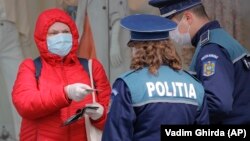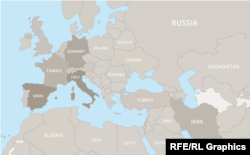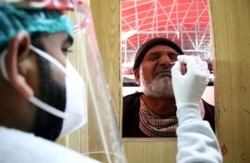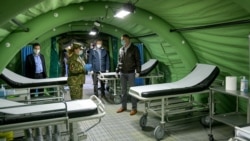When Romanian President Klaus Iohannis visited St. John the New hospital in the northern city of Suceava in October, he praised it as a shining example for the country’s patchy health-care system.
"We have here a model of good practice in the Romanian health-care system," said Iohannis, standing with hospital and city officials. “We want to have examples like this all over the country.”
Not anymore.
Five months later, the glowing praise for the health facility that was revitalized with European Union money has turned into harsh criticism.
The hospital, named after a 14th century Romanian saint, was shut down to be disinfected after the coronavirus spread throughout the facility and infected at least 181 medical workers -- including 43 doctors.
Hospital managers and local health officials have come under fire for mismanagement, negligence, and incompetence in allowing the mass infection to occur at the facility.

Critics say Romania’s heavily politicized local administration played a major role in allowing the situation to become so dire.
Infections Rising
The massive outbreak at the hospital and its environs has led to the Suceava region being compared to Lombardy, the epicenter of the horrific COVID-19 outbreak in Italy, the European country hit the hardest by the coronavirus.
“This is Romania’s Italy, it’s [our] Lombardy,” Sorin Ionita, a public policy commentator, told RFE/RL. "Suceava is the canary in the coal mine [for Romania]."
Suceava county is home to about 600,000 inhabitants, just over 3 percent of Romania’s total population of some 19 million people.
But as of March 31, it was home to more than 25 percent of Romania’s some 2,200 coronavirus infections due to the massive outbreak at the hospital.
Live Map: The Spread Of The Coronavirus
The Suceava region also accounts for about one-third of the country’s 78 COVID-19 deaths as of March 31.
And the number of infections for the region is likely to increase as officials await test results for 124 sick patients at the hospital to see if they have also contracted the coronavirus.
Interior Minister Marcel Vela announced the city of Suceava -- with a population of some 100,000 -- and surrounding area would be under a strict lockdown as of March 31 in an attempt to halt the spread of the virus.
It is the first city in Romania to be in a tight quarantine until mid-April, with only trucked goods allowed in.
Movements in the rest of the country have been restricted for almost a week.
In a live address on March 31, Iohannis reassured the inhabitants of Suceava that they will receive all food and medical supplies needed.
The enormity of the outbreak led to the hospital's manager and medical director as well as Suceava county’s public health chief to be fired.
New Romanian Health Minister Nelu Tataru spent three days in Suceava last week investigating the situation at the hospital. He told local media that “a conglomerate of irregularities” was to blame for the situation.
Tataru, who has been the public face of the ministry during the coronavirus crisis, was appointed health minister while he was in Suceava.
The appointment came after his predecessor, Victor Costache, was forced to resign on March 26 for his poor handling of the coronavirus outbreak.
After being named minister, Tataru said he was confident the hospital could be reopened soon, although staffing would be an issue as dozens of infected doctors and nurses are in quarantine.
Tataru, a member of the governing Liberal Party that took office this month, told Digi24 there were many reasons why the crisis occurred.
"The epidemiological inquiry didn’t manage to identity certain [coronavirus] cases, medical personnel were contaminated and isolated when it was too late, protective equipment was not used properly, and the crisis was mismanaged," he said.
Spreading The Disease
So how did a regional hospital in northern Romania become a flash point for the coronavirus?
On February 28, a 71-year-old man took a bus from the northern Italian region of Lombardy to his home in Suceava. Like many other Romanians since the 1989 fall of communism, he had migrated from the economically depressed Romanian region to Italy for a better-paid job.
Three days later, the man was admitted to St. John the New hospital with a fever, cough, and sore throat.
Shortly thereafter he became known as Patient 6, the sixth person in Romania to test positive for COVID-19.
RFE/RL's Coronavirus Crisis Archive
Features and analysis, videos, and infographics explore how the COVID-19 pandemic is affecting the countries in our region.
The infection quickly spread throughout the hospital, which is being blamed for failing to follow proper medical procedures in containing the deadly virus.
Mediafax news agency reported on March 25 that one nurse had treated 25 patients regularly without wearing any protective equipment after the outbreak. Another nurse said many medics had failed to get tested amid the outbreak and continued working, infecting others, including family members.
Such lax standards and poor hygienic practices seemed to be the undoing of the hospital, which had received millions of euros from Brussels in recent years for upgrades that made it one of the best in northern Romania.
"The system [at the hospital] was made to function in normal times, not when there’s a crisis," said Ionita. "Good equipment can’t save you when you lack [good] human resources and management."
Romania spends just 5.5 percent of its GDP on health care, about half of the European Union average. Many of the country’s best doctors and nurses routinely move to Western European countries for higher salaries.
Many others have resigned, often due to frustration with the lack of medical supplies or because of fatigue due to the crisis.
Iohannis has vowed to increase spending on the neglected health sector once the coronavirus crisis has susbsided, though the government has pumped extra funds into the health-care system to help workers cope with the demands of the pandemic.
Most medical workers and patients involved in the crisis at St. John the New hospital declined to speak to the media about the situation.
But the husband of a 70-year-old woman who died after catching the coronavirus at the hospital said, “It’s a joke at Suceava -- they gave her coronavirus and a week later they put her in a coffin.”
He blamed “the indolence of medics who treated her" in an interview with Digi24 in which his voice was altered to hide his identity.
Ionita was more pointed about the reported poor response of hospital management and local health authorities to the crisis.
"Hospital managers are politically dependent but, even more, the local public health authorities who theoretically should be under the control of the Health Ministry were people handpicked by parties and brought in to sleep on the job,” he told RFE/RL.
Among those who contracted the coronavirus at the hospital was Gheorghe Flutur, the chairman of the Suceava County Council and former Romanian agriculture minister.
Once the results of the tests on the St. John the New patients are known, those who test positive for the coronavirus will be sent to medical facilities in Radauti, Falticeni, and the large regional hospital in the northern city of Iasi if their conditions are serious.
Patients testing negative will be sent into self-isolation.
“This could have happened anywhere in Romania, in Dambovita, or in Constanta, [but] Suceava was just unlucky because it happened here first,” Ionita said.
Experts expect the pandemic -- which began relatively late in Romania -- to worsen in April but hopefully reach its peak shortly thereafter.
See Also: Five Things To Know About Coronavirus Tests














